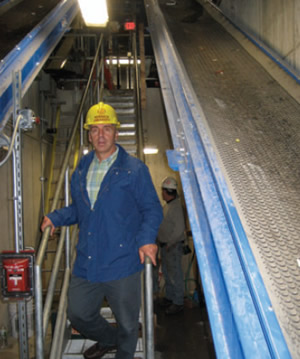Letting the Chips Fall
Norwich University fires up a new biomass facility in order to save approximately $1 million in annual fuel costs.

PHOTOS COURTESY OF NORWICH UNIVERSITY, OFFICE OF COMMUNICATIONS
Workers went about their business recently, banging and clanging as necessary to prepare for the first fire up, just days later, of Norwich University’s wood-chip burning facility.
Although the facility was still dormant, the heat was on: The $6.2-million plant is the culmination of a comprehensive process by the private military university to find an secure, economically and environmentally sustainable solution to its rising fuel oil costs. Another spur, according to Norwich: insulating the university “from disruptions in oil supplies.”
The date for that target fire up, and fall, were fast approaching.
One of the leaders of the effort, David Magida, chief administrative officer at the Northfield, VT, institution, led College Planning & Management on a tour of the 5,000-square-foot construction that abuts the campus’ existing power plant. Magida pointed out some of the features of the impressive, brand-new facility that will provide steam for heat, domestic hot water and process.
The features include:
- Two advanced wood-fired boilers, fueled by 13,000 tons of locally sourced wood chips annually, replacing the use of about 657,000 gallons of two kinds of fuel oils.
- An electrostatic precipitator that will trap more than 90 percent of the combustion process’ particulate matter.
- Arrangements to tap into the existing power plant infrastructure, such as the chimney and the original oil tank — it’s now for backup.
- Rails over the plant’s deep wood chip bunkers, enabling trucks to back in and efficiently deposit tons of chips, which are then moved through augers on conveyor belts toward the boilers.
Among the other results: Slashing soot emissions in half, and CO2 emission by a whopping 97 percent; creating 220 tons of ash… on its face a burden, but all of it can be used beneficially, as fertilizer.
Tips Concerning the Alternative Energy Plant Process
Reach out to your contractors and related contacts. Who in your extended network has, or knows a firm that has, built other such plants?
- Visit other campuses. Talk with the men and women there who work with similar power plants.
- Arm yourself with the facts, says Magida. That means all of the facts, from the short- and long-term finances to air quality to area traffic impacts. Anticipate likely questions from each stakeholder group and prepare accordingly.
- Forewarn. In other words, once you have the facts, share them. Again, all of them.
- “Don’t sugarcoat concerns,” Magida recommends. “Treat everyone as the professionals that they are, and seek their counsel.”
- Involve your campus and off-campus community. Use the process as an opportunity to renew and strengthen your college and town-gown relationships.
Seeking Alternatives
Magida explains that campus officials had been kicking around ideas for alternatives to fuel oil for years, considering propane gas and compressed natural gas, as well as wood chips. Prices for that last fuel have gone up over the years, but so has the level of efficiency of the biomass combustion process. So the focus fixed on wood chips.
In a related move, the campus had conducted an energy audit with SourceOne, a subsidiary of Veolia Energy, and Efficiency Vermont in an initiative that set energyuse goals on the Norwich campus while providing key information. University officials crunched the numbers, creating what Magida calls “thorough, detailed and conservative” financial models — Magida praises the input of Norwich CFO Lauren Wobby throughout the process — that showed a staggering potential advantage: an advanced wood chip plant could save about $1 million annually. At an overall project cost of $6.2 million, the payback period would be about six years, says Magida. Not bad at all, to put it mildly.

PHOTOS COURTESY OF SCOTT BERMAN
BACK TO THE FUTURE. Just one advantage of biomass energy is that, for the most part, it creates no harmful carbon dioxide emissions. The recently opened biomass fuel plant on the campus of Vermont’s Norwich University ushers in a new era of energy efficiency and fiscal responsibility for the school. The plant is projected to replace the burning of more than 650,000 gallons of fuel oil with 13,000 tons of wood chips from within a 100-mile radius each year, save approximately $1 million in annual fuel costs, and reduce total central plant soot emissions by half and sulfur dioxide and metal emissions by approximately 97 percent. It was designed to blend in aesthetically with other campus facilities, including the existing Central Power Plant.
Selling the Plan
Next came the board of trustees. He explains, “The board will challenge us, as they should.” And they did, in fact, with questions centering on technical aspects and that financial modeling. “They put us through our paces, very professionally,” Magida says. “They wanted to double and triple check us before committing to spending that kind of money.”
Other steps included visits to other biomass facilities — Magida says ones adept at handling wood impurities were particularly of interest. Eventually, Norwich went with Messersmith Manufacturing for the biomass boiler system.
Involving the Community
There was also the local community. Early in the process, the team at Norwich reached out to stakeholders in the surrounding area, fully briefing local zoning and planning boards. Among the boards’ questions, whether a second heating plant chimney would be needed. The answer was no; the new system would use the plant’s existing stack. Construction and operation noise, and how the new plant would look were concerns; the plant’s location deep within campus mitigated both latter issues.
Two other points emerged locally:
- A chimney plume. Norwich forewarned community stakeholders that, “on colder days, a larger white plume from the (central heating plant’s) chimney will be visible.” However, “this plume is mostly just water vapor.”
- Truck traffic. Annually, about 515 trucks will deliver wood chips, which given fewer oil deliveries, will mean 328 trucks on local roads each year. That includes as many as four trucks daily during the coldest weather — not a significant increase. Magida points out that according to the Vermont Agency of Transportation, about 248 trucks use nearby Route 12, a state highway, each day, so the extra wood delivery trucks “will not detrimentally affect traffic congestion or safety in the area.”

UP AND RUNNING. David Magida, chief administrative officer at Norwich University, oversaw the opening of a new biomass energy-generating facility in October. Oil supply disruptions and oil market uncertainties were some of the key drivers in undertaking the project.
Up and Running
Groundbreaking for the plant was in November 2012, and the ribbon cutting was on October 24, 2013. Before that ribbon cutting, however, and just several days after CP&M’s visit, the new boilers were switched on for the very first time. Naturally, it was a moment of some nervous anticipation. Yet, “everything worked beautifully. No problems or surprises,” Magida reports. “The Messersmith technician will work with other technicians from our mechanical, plumbing and electrical contractors to really put the equipment through its paces.”
In retrospect, a key for the team at Norwich, he believe, was its willingness to ask a lot of questions; of other colleges, contractors, engineers and architects, in addition to state and local officials. “There are some very experienced people out there. Don’t be too proud to ask for as much information as you can,” Magida says.
He’s clearly encouraged. Standing outside the new facility as workers went about their business, Magida didn’t hesitate, when asked for the bottom line, about what the plant means for the university. “Through careful analysis and careful planning, we’re getting something that’s extremely attractive financially and environmentally.”
Earth, Wind, Air and Fire
Here are just a few examples of institutions that are turning to renewable sources of energy to fulfill their needs.
GEOTHERMAL
Ball State University in Muncie, IN, is creating the nation’s largest ground-source, closed-loop district geothermal energy system on its campus. The system will heat and cool 47 buildings and result in $2 million in annual savings.
For a recent campus expansion, Miami University in Oxford, OH, decided that instead of expanding the coal-fired steam plant that heats the main campus, to switch to a geothermal heating and cooling system. The university estimates a saving of 16 million gallons of water per year with this project.
As of November 2012, approximately 600,000 square feet of building space on the Boise State University campus in Idaho was heated by geothermal energy.
WIND
In February, Indiana State University (ISU) dedicated a wind turbine on its Terre Haute campus. The turbine will generate between 5,000 and 11,000 kilowatts annually to offset some of the university’s energy usage.
A wind power project on the campus of the University of Maine at Presque Isle (UMPI) offsets approximately 33 percent of the annual campus energy use costs, reduces UMPI’s carbon emissions substantially, and is a widely used learning tool in the university’s curriculum.
The newest member of Alfred State College’s growing renewable energy family is currently catching the breeze above the Alfred, NY campus — a 100-kilowatt grid-tied wind turbine that will offset some of the college’s electricity usage.
SOLAR
With its newest sets of energy-capturing panels, 44 percent of the campus of Butte College in Oroville, CA, will be powered through solar energy —making the college the largest solar producing campus in the state. The college also projects it will save $32.6 million in reduced energy costs over 20 years.
A solar canopy was recently built behind Odum Library on the campus of Georgia’s Valdosta State University. The canopy is a 10-kilowatt solar array that produces energy that goes directly to Odum Library, and does not go to the Georgia Power grid.
In June, The Texas A&M University System announced the creation of the largest solar test site in the world to power the entire Texas A&M University-Central Texas campus and greatly expedite the development of photovoltaic solar technologies.
BIOMASS
In 2003, the University of Iowa Power Plant pioneered a unique and innovative source of fuel — oat hulls — through a partnership with Quaker Oats in Cedar Rapids. The energy produced from oat hull combustion replaces energy that would have been generated by burning coal. Through 2012, this initiative has displaced 183,225 tons of coal.
The Bioenergy Research & Demonstration Facility on the Vancouver campus of the University of British Columbia (UBC) is the first of its kind in the world of a community-scale combined heat and power (CHP) system fuelled by biomass. UBC is a community of more than 47,000 students plus staff and faculty, with over 400 buildings, occupying a site of more than 900 acres.
A biomass unit was completed in June on the campus of Northern Michigan University in Marquette. It will save the university about $1.5 million each year. It is expected to produce up to 18 percent of the university’s electricity.
This article originally appeared in the College Planning & Management December 2013 issue of Spaces4Learning.